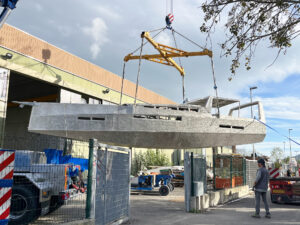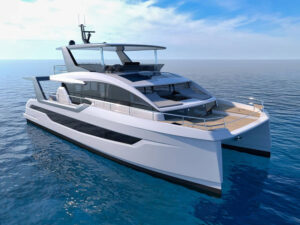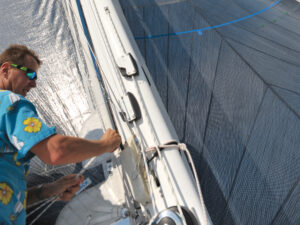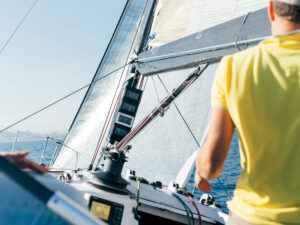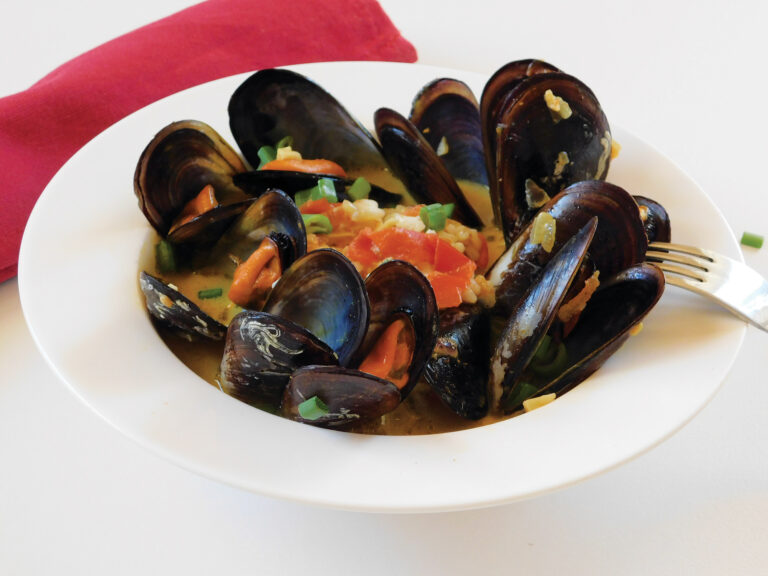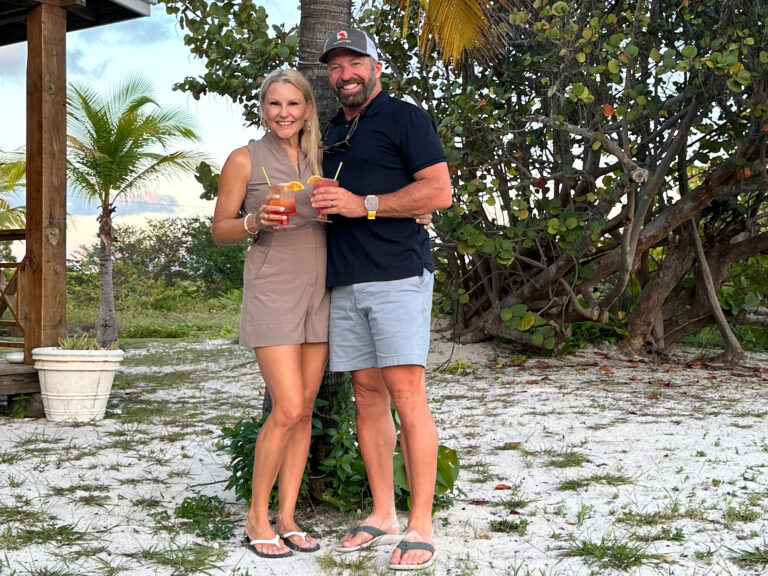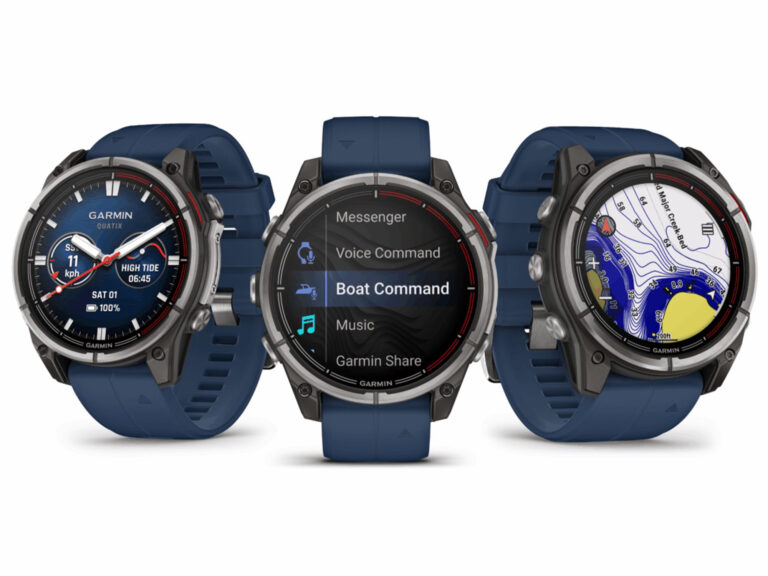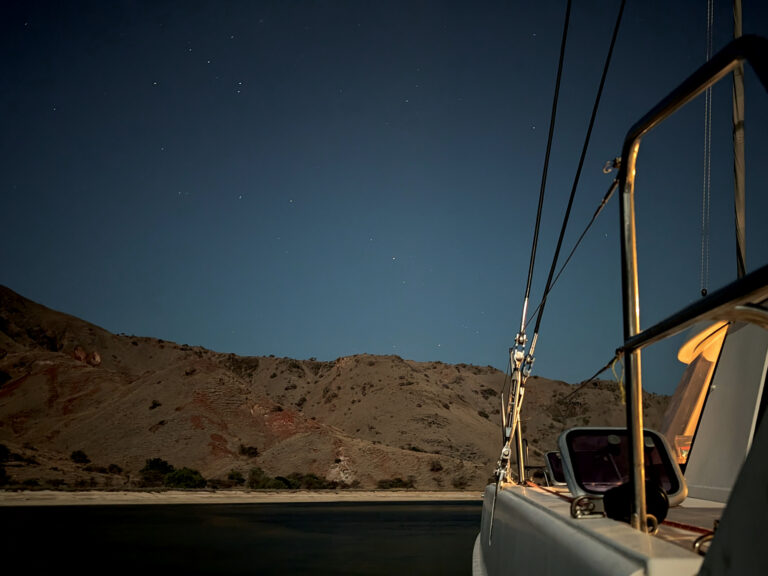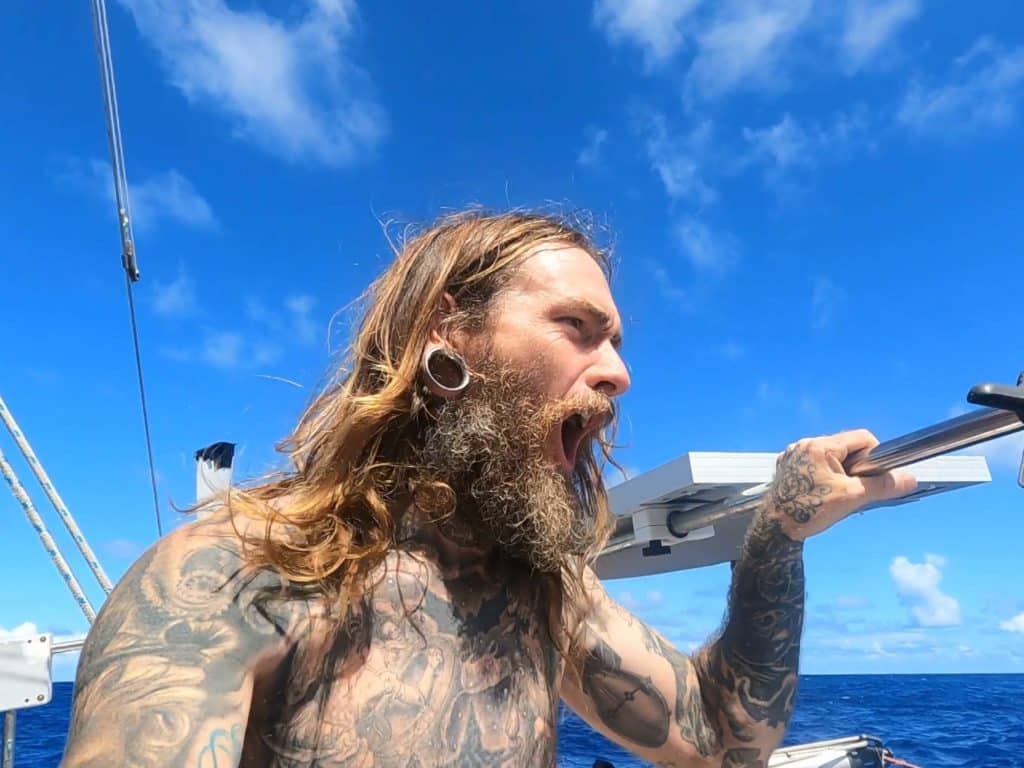
The sea will allow you to encounter yourself, if you let it. At age 16, James Frederick traveled to San Francisco, stood on the beach, and saw the ocean for the first time. “I just stared at it,” Frederick says, recalling the moment. “All I could think was: This water has never stopped moving.”
Frederick grew up in the California desert. At 15, he dropped out of high school and lived on the streets of Los Angeles. In the ’90s, he worked as an artist and musician, performing experimental soundscapes at galleries and museums across Europe. Today, at 47, with tattooed hands and gauged ears, Frederick looks more punk rock than Polo. But he’s an ocean sailor. And his recent 32-day solo voyage from Los Angeles to Hawaii is about more than a dream realized; it’s about what happens when life goes to crap, plans are shattered, and the only thing left to do is to go to sea.
In 2014, Frederick was in Russia, on the island of Kronstadt, studying maritime history as an artist in residence with the National Centre for Contemporary Arts. He was interested in boats but believed that sailing was out of reach. However, after landing an art residency that teamed scientists, sailors and artists on an expedition boat in Scotland’s Orkney Isles, Frederick felt a call.
“When I stepped off that sailboat, my future was forever changed,” he says. “But I had no idea what was to come.”
Frederick abandoned his pursuit of art and made sailing his life. Back in Los Angeles, he used meetup and crew-placement websites to get on any boat he could, racing and delivering yachts up and down the West Coast. In 2017, he found Triteia, a 1965 Alberg 30, rotting between an oil refinery and a recycling facility where old boats are cut up and carried to the dumpster.
“It’s a heartbreaking place where boats go to die,” Frederick says. “But there were angels playing trumpets when I saw this boat.”
Frederick bought Triteia for $2,400 and began sailing Southern California. Months later, he met Camille, a fine artist, and the adventure began. Together, they circumnavigated Catalina Island, anchored in the Channel Islands, and married aboard Triteia.
“Waking up under anchor with the person I love gave me a glimpse of the life I had been dreaming of living,” Frederick says.
But there was a bigger dream: He wanted to sail the world.
Working paycheck to paycheck, Frederick readied Triteia for cruising. He swapped the seized engine for a rebuilt Yanmar, built a custom compression post, and installed an integral freshwater tank and a custom mast. He upsized the rigging, and upgraded the ground tackle, hard dodger and windvane. Triteia’s four-year refit was extensive; the labor was hell. Nearing completion, Frederick was so beaten, he thought that finishing the boat might break him. You are doing this for the magic hours you will experience at sea, he told himself.
“That first day was incredibly difficult … I was stunned and alone, sailing for Hawaii in hope that the solitude might help heal my shattered heart.”
In June 2021, Frederick embarked on a 2,300-nautical-mile solo voyage from Los Angeles to Hawaii. If all went to plan, Camille would join him there and cruise the islands.
But there was trouble. Thirty miles out, in heavy wind and pounding seas, the bolts that secure Triteia’s self-steering windvane began to back out. Later, 262 miles off the California coast, the bolts stripped and failed.
He turned the boat around, limped back to Los Angeles, and fixed the windvane. With Hawaii on pause, he and Camille made a new plan to cruise the West Coast. Then, only days from departure, things went sideways. Camille left James; their marriage came to an abrupt end.
“I was on a mooring ball in Redondo Beach with no dog and no wife, completely shattered as to what happened to my life,” he says. “But I also thought: The boat’s ready. The boat’s provisioned. I’m sailing to Hawaii.”
At a guest dock in Marina Del Rey, a small group of friends streamed in and offered support, including Capt. David Stovall, a former bosun’s mate in the US Navy. “When you’re hurting, isolation at sea isn’t always helpful,” he says. “But James is a good guy with a strong value system, and he’s an expert sailor. So if anyone could handle a long solo passage amid this kind of loss, it’s James.”
On August 12, 2021, Frederick woke early, went to the market, and bought a few provisions. On the walk back to the dock, fear washed over him. “I did not want to go,” he says. “I don’t rattle easily, but I felt so scared and vulnerable. Still, my feet kept moving forward.”
Frederick put the food in Triteia’s fridge, started the engine, and did a final equipment check. “Almost every aspect of my life has turned upside down and changed,” he said in a video recorded that morning from inside Triteia. “The only thing that makes sense is to put to sea.”
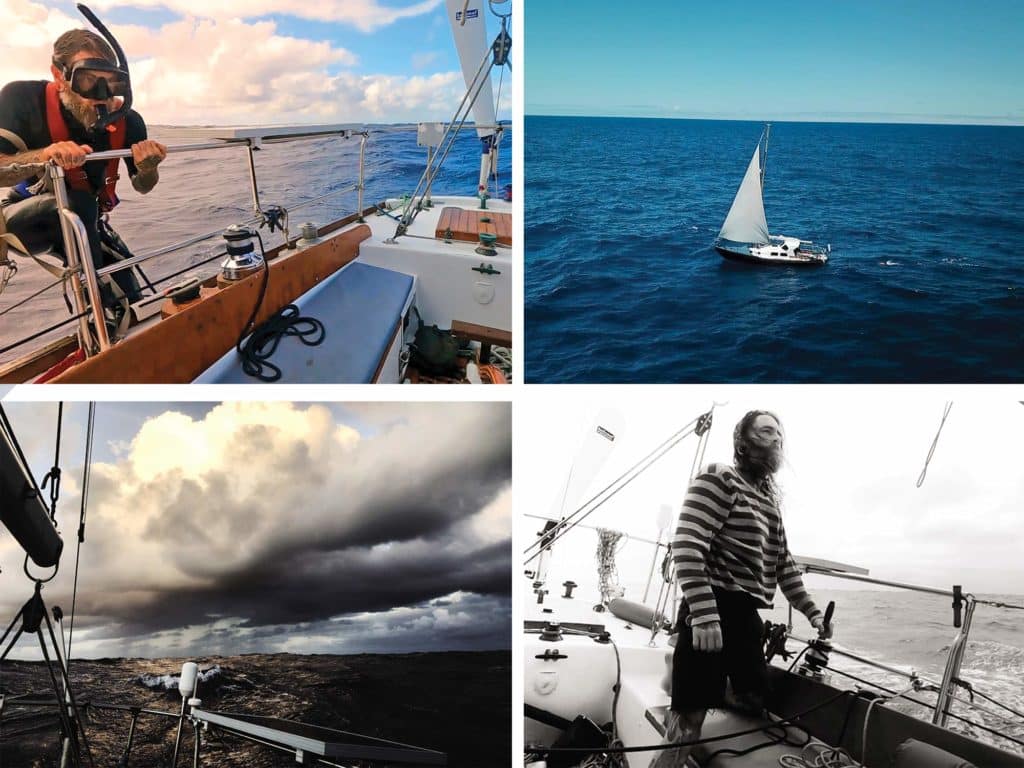
A second push to Hawaii would begin better than the first. In mellow conditions, Frederick got his sea legs and motored offshore from Marina Del Rey. But as Triteia found course for Hawaii, Frederick was reeling.
“That first day was incredibly difficult,” he says. “My wife had made it clear that there was nothing I could do to get her to stay. I was stunned and alone, sailing for Hawaii in hope that the solitude might help heal my shattered heart.”
Years earlier, when Frederick lost his mom, he hid from the grief. This time, he knew he would need to accept the pain. The first night of the passage, he slept in the cockpit under the stars and woke every 15 minutes to watch for ships. He wrote in Triteia’s log:
Have you ever thought about what it means to be alone? I mean, truly alone and on your own? Sometimes we reach crossroads in our lives that make us just want to sit in silence for a bit.
Sometimes that silence is extremely loud. Other times, the silence is far too quiet.
On the morning of Day Two, Frederick unfurled the headsail and enjoyed 10 knots of warm air. If things went well, he’d reach Hawaii in 22 days. On his satellite phone, encouraging text messages streamed from his brother Colby and close friend Sarah. Meanwhile, Frederick’s brother David and Stovall monitored Triteia’s position on PredictWindand alerted Frederick of nearby ships.
Brooding clouds brought drizzle and dumped rain, and fluky wind combined with tall seas. Frederick trimmed the sails, wrote, read, and edited video as Triteia logged miles. “Ship’s business kept my mind distracted, but every time I laid down in the bunk, I’d remember I didn’t have a family,” Frederick says.
Late in the night, on Day Four, while sailing through cold and fog, Frederick awoke from his sleep. “Absolute terror,” he says. “The masthead light and sails were casting an ominous shadow that looked like the mainsail of another boat. I about sh-t myself.”
A few days later, Frederick had another scare. One mile off Triteia’s port bow, a tanker was lumbering past. Triteia’s AIS had been working at the start of the passage but had quit several days out.
“I wasn’t on their radar, and they weren’t on mine,” Frederick says. “But sailors on small boats have long navigated oceans without electronics. Equipment is going to break. It’s just the reality of sailing.”
Frederick has a low tolerance for BS and a high threshold for stress. He also does a tremendous amount of reading. In the boat’s library, he brought Two Against Cape Horn by Hal Roth and Boundless Sea by David Abulafia, along with a cruising guide to the Hawaiian Islands. While reading, he highlighted details and jotted notes, imagining himself exploring Hawaii’s bays and coves, and snapping photos of Triteia in picturesque anchorages.
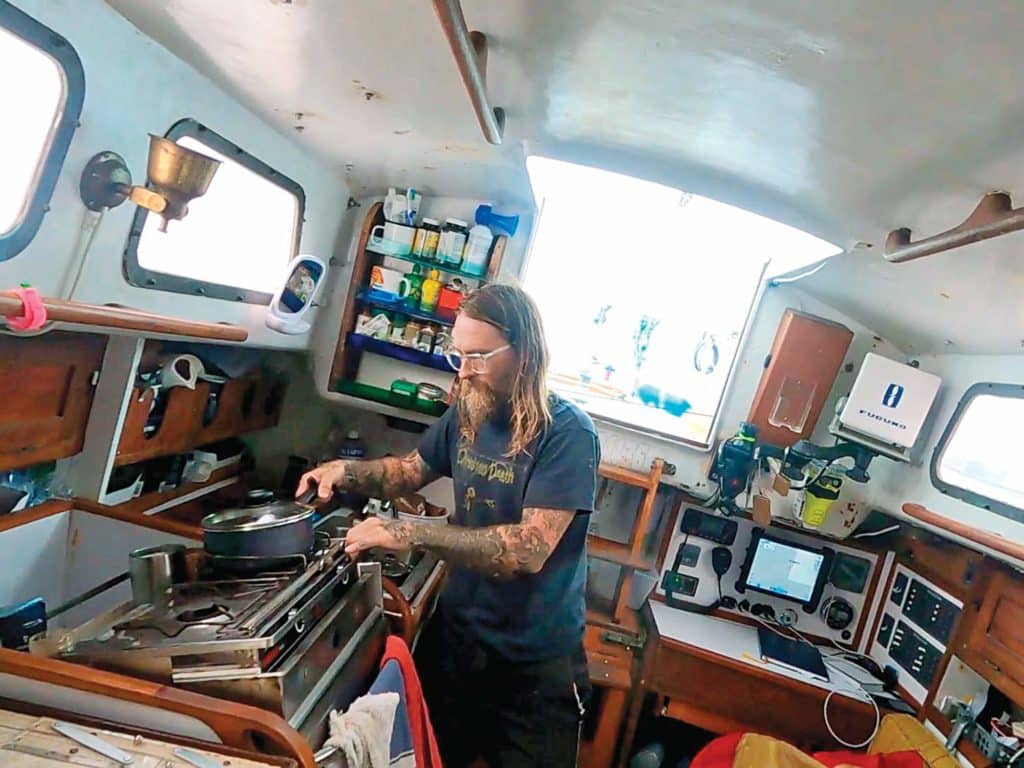
On Day 10, a wave rounded down Triteia as a gust hit, blowing out the clew of the mainsail. Later, another gust came. “With full sails up, we were hit with 20 knots and completely laid over,” Frederick says. “The winch was totally awash. I had to reach into the sea to release the jib sheet and depower the sail.”
Offshore, the dolphins, terns and sea life vanished. Frederick was actually alone now. Then, the albatrosses appeared. Among the largest and most legendary birds, albatrosses are endangered and often employed metaphorically for a person bearing a burden or facing an obstacle. Frederick watched as they glided in circles overhead and followed Triteia. He wrote in his log:
According to sea lore, to spot an albatross is a good omen. It is said albatrosses are the souls of sailors who were lost at sea, watching over earthbound sailors as they cross the oceans. I will never forget this experience.
Heartbreak is real, but beauty is medicine. White clouds contrasted with shifting hues of blue sky over the Pacific, reminding Frederick of American sculptor James Turrell. A Quaker and a pilot, Turrell’s work explored light and the connection between humans and space—even empty space. Alone at sea, Frederick knew that he was inside that void. At the same time, there was compassion in the vast emptiness of the sea.
On Day 13, Frederick and Triteia passed the halfway point on the rhumb line between Marina del Rey and Hilo, Hawaii. Squinting at his chart, he celebrated by nodding and climbing back into his sleeping bag. Later, he wrote:
It was a day of endlessly adjusting course and lying in my bunk wondering at what point in life my passions had become so masochistic? Why couldn’t I be passionate about log cabins? Log cabins are lovely, are they not? But alas, here we are 1,100 nm from any other humans besides all the other sailors on ships plying this sea. Here’s to halfway!
After two weeks at sea, trouble arrived. Frederick was in the trade winds, hand-steering in 17 knots of wind and following seas, when the tiller went slack. One thousand miles from Hawaii, he’d lost the ability to steer.
“I felt time come to a standstill,” he says. “I sat dumbfounded, just staring.”
Frederick clipped into his harness, went forward, and dropped the sails. In rolling waves, he put a GoPro in the water and performed an initial inspection. Good news: No water was coming into the boat. Bad news: The rudder was damaged.
Stovall was in Santa Monica when he got an emergency text message from Frederick over Iridium Go!: “I was immediately alarmed,” he says. “A lot of fine yachts have been abandoned at sea due to rudder failure.”
In Maine, Noah Peffer also received a message over satellite phone. Peffer worked with Frederick in the art world; he’s crossed the Pacific, and cruised the East Coast, Caribbean and Bahamas. “I know people who are complete Vikings,” he says. “They all said: ‘Holy sh-t! No rudder? A thousand miles from Hawaii?’ Nobody thought this would be easy.”

Stovall contacted the US Coast Guard in Hawaii, and provided Triteia’s position, Frederick’s overall condition, and the amount of food and water aboard the vessel.
“At that point, there wasn’t much [the Coast Guard] could do,” Stovall says. “If they rescued James, he’d have to scuttle the boat.”
To scuttle is to intentionally sink, and Frederick wasn’t having it.
“My whole life and everything I owned was on board Triteia,”he says. “I knew I would exhaust all possibilities before it came to that.”
As Triteia drifted, Frederick put on diving gear and lowered himself into the water. From what he could see, the rudder post had separated from the rudder itself; there was a chip out of the rudder, and near the damage, Frederick noticed flecks of red paint. They were evidence, perhaps, that the boat had struck a submerged object.
Back aboard, Frederick tucked in a third reef and deployed his rigid Sea Squid drogue to limit Triteia’s progress off course. Then, he collapsed into his bunk and slept. Later, he wrote in the ship’s log:
My heart was already in tatters, and now my ship, my home, and all of my dreams were adrift in one of the most remote places on the planet. I sat in the cockpit staring at my beautiful boat, imagining her cabin filling with water.
After some sleep, Frederick tested potential steering solutions. Triteia’s windvane has an auxiliary rudder, but it would steer the boat only with the sails down and the motor off. Alternatively, a floorboard could be fashioned into an emergency rudder. But hand-steering for 1,000 miles wouldn’t fly.
“I know people who are complete Vikings. They all said: ‘Holy sh*t! No rudder? A thousand miles from Hawaii?’ Nobody thought this would be easy.”
Frederick remembered his heroes. Tami Oldham Ashcraft survived 41 days adrift after dismasting in a hurricane while crossing from Tahiti to San Diego. Miles and Beryl Smeeton twice pitchpoled their ketch on attempts to round Cape Horn. Beryl was thrown overboard and broke her collarbone, and the boat nearly sank. Still, the Smeetons built a new mast inside the cabin, and sailed on to Chile.
“These stories had me feeling grateful that my ship was stout,” Frederick says. “I also knew I had the necessary equipment on board and the good fortune of a great shore team.”
Peffer and Stovall believed that the best way forward was to steer Triteia by drogue, a device that can towed behind a boat to slow forward progress and make the boat easier to steer in heavy weather. Receiving instructions via text on Iridium Go!, Frederick lashed a spinnaker pole to Triteia’s stern. He fed two lines through blocks amidships, ran them back aft through the ends of the pole, and tied them to the drogue.
“At first, I couldn’t get it to work,” Frederick says. “With wind on the beam, the boat would run off and ignore the drogue.”
At Stovall’s suggestion, Frederick added a 4-pound dive weight to submerge the drogue. Meanwhile, Peffer advised Frederick to drop the main and run on headsail alone. Test, fail, adjust, repeat. “Sometimes I’d pay out too much headsail and overpower the drogue,” Frederick says. “The other key was to maintain enough resistance to control the drogue while not killing the forward momentum needed to steer.”
It took three days to dial in the system. By the fourth day, Frederick was running on full headsail.
“I was relieved and amazed,” Frederick says. “For the first time since leaving California, I felt happiness.”
Still, Frederick’s shore team had concerns. “One of my worries was that he’d fatigue from having to constantly manage the setup,” Peffer says. “But one of the best surprises was that he could lock down the system and not touch it for hours.”
Drogue in tow, Triteia inched along at 1 to 3 knots. By Day 20, nearly six days after rudder failure, with Hawaii still 800 miles away, it was clear that there would be no shortcut in this journey. The experience of being rudderless, both in life and at sea, was here for Frederick to deeply experience. He wrote in Triteia’s log:
Sometimes we need to see the brilliant blue skies fall into the night—a night that holds an impossible number of stars—and to feel the sea humble you while never even taking notice as she continues to move. You might not believe this, but you would be amazed at what you could do when you are forced to. Sometimes the only path forward requires a certain amount of resistance.
For 18 days, Frederick steered by drogue. Sometimes the jury-rig would fail, and Frederick would be forced to hang off the back of the boat and hand-turn the windvane rudder to maintain course. Wet, cold and pounded by seas, he often screamed at the waves. But intense moments of beauty emerged. Schools of yellow dorado and albacores offered transcendence. Pacific bluefin tuna brought magic. Golden sunsets with albatrosses invited wonder.
“The colors were as vivid as a Flemish still-life painting,” Frederick says, “where the darkness plays as much of a role as the color.”
On Day 31, after hours of squinting at the horizon, Frederick spotted the island of Molokai, 41 nautical miles off his port bow. “Yes!” he screamed.
The channels between the Hawaiian Islands can be treacherous. Nearing Oahu, James radioed ahead to arrange for a towboat, but none were available.
“I couldn’t believe it,” he says. “Even this close to Honolulu, I was on my own.”
Frederick started the engine and motored Triteia slowly, so as not to overpower the drogue. For the final six hours of the passage, he hung off the stern and steered with a foot to manage the increasingly ineffective windvane.
At Diamond Head, the prominent volcanic crater visible on approach to Oahu, the wind was blowing at 20 knots. Large waves were breaking on the reef. Entering the harbor rudderless would be risky, if not crazy, so Frederick dropped anchor at Waikiki Beach.
Capt. Mike La Rose, who runs tour boats in Hawaii, had been following Frederick’s passage via Instagram updates from the shore team. La Rose reached out to help, and soon arrived aboard his Sunnfjord 38 trawler.
“It’s so crazy,” Frederick said as La Rose towed Triteia into Ala Wai Harbor. “I can’t believe it’s done.”
After 32 days and 2,300 miles alone at sea—1,000 miles without a rudder— Frederick made landfall at Oahu. He stepped off the boat and collapsed on the dock, the dream of sailing to Hawaii now living within him. Later he wrote:
I’ve stared silently at some of the most beautiful sunsets, screamed into the air until my throat felt broken, cried for lost love, and laughed with joy at the sight of the albatrosses. I have learned a great many things in the past 30 days, but may have more questions now than ever before.
The sea is full of contradictions: welcoming and hostile, violent and serene—inviting us into a meditation on power and powerlessness, fear and awe, holding on and letting go. As for Frederick, it’s clear that his experience at sea has forever changed him. At the same time, he’s still very much that kid he was at 16, standing on the beach, staring speechless at an open expanse that never stops moving.
James Frederick’s harrowing sail to Hawaii, told by David Blake Fischer, appeared in the June/July issue. Check out James’ thoughts on the article, below.
James Frederick is currently cruising the Hawaiian Islands aboard Triteia. A video of his 2021 passage from Los Angeles to Hawaii is available on YouTube. Additional details can be found in his book, The Logs of the Good Ship Triteia. Follow him on Instagram @james.the.sailor.man.
David Blake Fischer lives in Southern California. His writing has appeared in McSweeney’s, Buzzfeed, the Moth, Good Old Boat and other publications. Follow him on Instagram @sailingdelilah.

